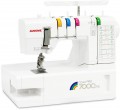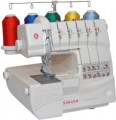Type of sewing machine
The general type of sewing machine, which determines its functionality and specific application.
—
Electromechanical. The classic, simplest type of sewing machines: they do not have computer control, all operating parameters are adjusted mechanically, and their use is limited to the simplest types of seams.
-
Computerized. Sewing machines equipped with built-in computers that control the sewing process. Thanks to this, they have a more extensive set of functions and are more precise in setting than electromechanical ones, although they cost accordingly. Note that in this case we mean exclusively computerized sewing machines; embroidery and sewing-embroidery machines are divided into separate categories (see the corresponding paragraphs).
—
Embroidery. Such machines were initially intended only for embroidering patterns, and are practically not suitable for work outside this specialization (regular sewing, hemming). They have appropriate design features, are equipped with a hoop and embroidery feet, and are often equipped with both a set of built-in presets (for example, embroidering letters of the alphabet) and the ability to connect to a PC and download patterns.
—
Sewing and embroidery. Machines that can be used for both sewing and embroidery. The design and sewing capabilities are similar to computerized
...models (see the corresponding paragraph), but are complemented by an embroidery unit, hoop and other embroidery equipment. And the built-in capabilities usually include both basic embroidery elements (crosses, stars, satin stitch, etc.) and the ability to embroider using patterns downloaded from a computer. Such machines are very versatile, but in terms of specific capabilities they may be inferior to more specialized models.
— Overlock. A special type of sewing machine designed primarily for seaming and trimming the edges of materials. An overlocker covers the edge of the fabric with a special seam, which prevents fraying, fraying and deformation. One of the design features of such devices is the presence of several working threads, from 2 to 10 (most often 3 or 4).
— Coverstitching machine. Devices designed to create the so-called. cover stitch - a flat elastic seam that is most often used to hem the folded edge in knitwear, as well as in some types of joints. Such machines are not used for other purposes.
— Coverlock. Devices that combine an overlocker and a cover stitching machine in one housing. For more information about each of these varieties, see the corresponding paragraph. Here we note that a carpet lock is actually a universal tool for processing edges: it is capable of overcasting them, cutting off excess fabric and hemming the folded edge with a cover stitch. In addition, many modern carpet stitchers are also capable of stitching materials (mainly with a two-thread chain stitch).Number of stitches
The number of stitches that a sewing machine can sew. The larger this number, the more extensive the capabilities of this model, the wider the choice the user has; however, it wouldn’t hurt to clarify the specific range of supported stitches separately.
The fewest options - mostly up to 25 - are provided in electromechanical machines, as well as specialized devices such as overlockers and carpet lockers (see “Type”). In computer-controlled devices, the number of lines can be in the dozens, and some also allow you to download additional options from the computer.
Max. stitch width
The maximum stitch width provided by a sewing machine.
Most modern sewing machines are capable of working not only with the simplest longitudinal seam (when punctures with a needle occur strictly one after another), but also with seams that cover a certain width - for example, zigzag and various decorative ones. And in overlockers, such opportunities are generally available by definition.
The larger the maximum stitch width, the correspondingly wider the machine’s ability to work with specific types of seams (all other things being equal). An indicator of up to 5 mm is typical mainly for entry-level devices, 5 - 7 mm - average, 7 mm and more - advanced.
Max. presser foot height
Distance from the working surface to the foot in the uppermost position. Must be taken into account when working with thick fabrics.
Sewing speed
The maximum sewing speed provided by the sewing machine. In the vast majority of models, this parameter can be adjusted, so if necessary, you can sew at a lower speed.
The more stitches a machine makes per minute, the higher its productivity, the better suited it is for large volumes of work. At the same time, it is worth considering that high speed has a corresponding impact on price and energy consumption, and it is not always required. Detailed recommendations on choosing the optimal speed for certain types of work can be found in special sources.
Presser foots
Виды лапок, поставляемых в комплекте со швейной машинкой.
— Универсальная. Лапка, используемая для стандартных швейных операций — преимущественно прямых строчек и зигзагов.
—
Лапка оверлочная. Лапка, предназначенная для выполнения оверлочной обработки. По определению встречается в устройствах с функцией оверлока (см. «Тип»), однако может предусматриваться и в традиционных швейных машинках. В последнем случае такая лапка, разумеется, не заменит полноценного оверлока, однако в некоторых ситуациях она позволяет обойтись без него.
—
Верхний транспортер ткани. Дополнительный транспортер для ткани, устанавливаемый сверху, вместо штатной лапки в дополнение к стандартному нижнему транспортеру. Такое приспособление облегчает работу с тонкими, деликатными и скользящими тканями, а также сшивание вместе нескольких слоев ткани: материал сдвигается максимально равномерно, без перекосов и смещений.
—
Лапка для вшивания молнии. Лапки для вшивания молнии могут иметь разный размер и конструкцию — в частности, существуют специальные приспособления для вшивания потайной молнии. Конкретные особенности данного приспособления стоит уточнять отдельно.
—
Лапка для декоративной строчки. Лапки, предназначенные для различных разновидностей декоративной строчки. Такая строчка может и не иметь функциональной
...роли, ее основная задача — подчеркнуть определенный элемент одежды (края, карманы, отдельные швы и т. п.). В любом случае линия стежков обычно должна строго следовать контуру, вдоль которого она наносится — а этот контур может состоять как из прямых, так и из кривых линий. Специальные лапки для декоративной строчки упрощают задачу: они оснащаются линейками или другими приспособлениями, позволяющими контролировать параллельность стежков.
— Лапка для атласной строчки. Данная лапка будет пригодна для аппликаций и другой работы, где часто используется зигзагоподобные стежки.
— Лапка для потайной строчки. Лапка, предназначенная для потайных швов, применяемых при подгибании края ткани. Оснащается приспособлением, которое обеспечивает подгиб ткани и в таком положении подает ее под иглу.
— Лапка для квилтинга. Специальные лапки для выполнения квилтинга — лоскутного шитья. При таких работах приходится сшивать ткань в несколько слоев, а также выполнять фигурные швы. В крайнем случае для квилтинга можно применять и обычную универсальную лапку, но пользоваться специальным приспособлением все же значительно удобнее.
— Лапка для вышивания монограмм. Лапка для вышивания монограмм позволит сделать вышивку на любом объекте, тем самым «украсив» его своей подписью или же эмблемой какого-либо учреждения, фирмы, спортивного клуба.
— Лапка для выметывания петли. Лапка, предназначенная для образования петель. С ее помощью отпадает надобность в ручной работе. Все за вас сделает швейная машинка, что и время сократит, и качеством порадует.
— Лапка для пришивания пуговиц. Лапка, предназначенная для фиксации пуговицы на ткани во время пришивания. Имеет специальный выступ, направленный вниз: когда основная часть лапки прижимается к пуговице, этот выступ прижимает ткань и предотвращает ее скольжение.
Кроме вышеназванных, в комплект поставки могут включаться и другие виды лапок — например, для атласной строчки, для обработки срезов и т.п.Led lighting
Встроенная система подсветки, освещающая рабочий столик машинки, которая выполнена на светодиодах. Помимо яркого освещения области работы
швейные машинки с LED подсветкой еще имеют пониженные на фоне классических ламп показатели энергозатрат.
Power consumption
The power consumed by the machine during operation. Usually, the maximum power value is indicated in the characteristics.
Most of the electricity supplied to the machine is consumed by the engine, so this indicator primarily describes the power of the engine. The higher this power, the faster the machine can work and the better it is suitable for working with dense fabrics. However, there is no strict dependence here, much also depends on the general specialization of the unit.

